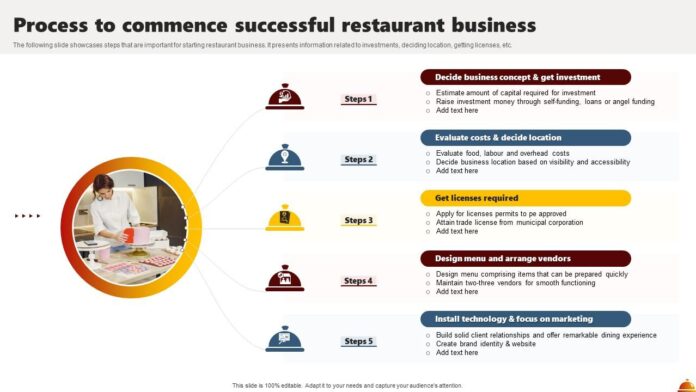Opening a restaurant is a dream for many aspiring entrepreneurs, but it takes more than passion for food to run a successful business. From concept development to grand opening, every step requires careful planning, dedication, and strategic execution. Whether you’re launching a small café or a fine dining establishment, here’s a step-by-step guide to help you open a successful restaurant.
- Develop a Solid Concept and Brand
The first step to launching a restaurant is having a clear vision of what type of dining experience you want to offer. Your concept and brand will shape the design, menu, marketing, and overall customer experience.
Define your concept: Are you opening a casual eatery, a fine dining restaurant, or a food truck? Consider the type of cuisine you want to serve and the ambiance you want to create. Your concept should appeal to your target market and stand out in the local dining scene.
Create a brand identity: Your restaurant’s brand encompasses its name, logo, color scheme, and overall personality. Choose a name that reflects your concept and resonates with your target audience. A strong, recognizable brand will help attract customers and build a loyal following.
- Conduct Market Research and Identify Your Target Audience
Before diving into any major decisions, it’s essential to conduct thorough market research to understand the industry landscape and ensure there’s demand for your concept.
Study competitors: Visit local restaurants and study their menus, customer service, and pricing strategies. Identify what works for them and areas where you can differentiate your restaurant.
Define your target audience: Understanding your potential customers will guide your menu, pricing, and marketing strategy. Are you targeting young professionals, families, or food enthusiasts? Knowing your audience helps you tailor your restaurant’s offerings to their preferences.
Analyze market trends: Stay updated on the latest restaurant trends and consumer dining habits. Health-conscious dining, plant-based menus, and locally sourced ingredients are some trends you may want to incorporate into your concept.
- Create a Detailed Business Plan
A well-thought-out business plan is critical to the success of your restaurant. This document will not only guide you through the startup process but will also be required if you seek financing from investors or lenders.
Executive summary: Provide an overview of your restaurant concept, mission, and vision.
Market analysis: Summarize the results of your market research, including competitor analysis and your target audience.
Operations plan: Outline how you will run the restaurant day-to-day, including staffing, suppliers, and management structure.
Menu development: Design a preliminary menu with detailed pricing for each item.
Financial projections: Include start-up costs, revenue forecasts, operating expenses, and break-even analysis. This will help you understand the financial health of your business and determine if it is viable.
- Secure Funding for Your Restaurant
Starting a restaurant requires significant financial investment, and securing funding is a crucial step. Your business plan will serve as a tool to present to potential investors or lenders.
Estimate start-up costs: Restaurant start-up costs can include leasing or buying property, kitchen equipment, renovation, licenses and permits, inventory, and initial marketing.
Explore funding options: You can fund your restaurant through personal savings, business loans, investors, or crowdfunding. Each option comes with its own risks and benefits, so choose the method that fits your financial situation and long-term goals.
Monitor cash flow: Cash flow is crucial in the restaurant business, especially in the early months. Make sure you have enough capital to cover operating expenses until your restaurant becomes profitable.
- Choose the Right Location
Location can make or break a restaurant. Choosing the right location is key to attracting customers and ensuring long-term success.
Consider foot traffic and visibility: A high-traffic area with good visibility is ideal for attracting walk-in customers. Corner lots or areas near popular shopping centers or entertainment venues can be prime locations.
Assess your target market: Ensure the location is convenient for your target audience. If you’re targeting young professionals, consider business districts. For families, suburban areas with ample parking might be better suited.
Evaluate rent and overhead costs: While prime locations are important, they often come with higher rent. Make sure the cost of your location aligns with your budget and financial projections.
- Obtain Licenses, Permits, and Insurance
Every restaurant must comply with local, state, and federal regulations. It’s crucial to secure the necessary licenses and permits to operate legally.
Business license: This is required to legally run a business in your location.
Foodservice license: Ensure your restaurant meets health department standards for food safety and sanitation.
Liquor license: If you plan to serve alcohol, you will need a liquor license, which can take time to obtain.
Insurance: Protect your restaurant with the right insurance coverage, such as general liability, property insurance, and workers’ compensation insurance.
- Design Your Restaurant Layout and Purchase Equipment
The layout of your restaurant will impact the customer experience as well as the efficiency of your staff. Design your restaurant to optimize flow while creating a welcoming atmosphere.
Create a floor plan: Design the layout of your dining area, kitchen, storage, and restrooms. Make sure there’s enough space for customers and staff to move comfortably.
Choose furniture and décor: Your furniture, lighting, and décor should align with your restaurant’s brand and concept. Consider the comfort and experience of your guests when selecting furniture.
Purchase kitchen equipment: Invest in high-quality kitchen appliances and equipment, such as ovens, refrigerators, stoves, and preparation stations. Working with an experienced kitchen designer can help ensure you optimize the layout for maximum efficiency.
- Hire and Train a Talented Team
The success of your restaurant will heavily depend on the quality of your team. From the chef to the front-of-house staff, everyone should share your vision and be passionate about delivering excellent service.
Hire skilled staff: Look for chefs, cooks, servers, and managers with experience and a positive attitude. Consider their ability to work under pressure and their fit within your restaurant’s culture.
Provide thorough training: Ensure your staff is well-trained in your restaurant’s procedures, customer service standards, and food safety regulations.
Foster a positive work culture: A happy team will deliver better service. Create a supportive, inclusive work environment where employees feel valued.
- Develop a Marketing Strategy
A strong marketing strategy will help you build buzz and attract customers. From social media to traditional advertising, promoting your restaurant before and after the opening is key to driving traffic.
Build a website: A professional website with your menu, location, hours, and contact information is essential.
Leverage social media: Use platforms like Instagram and Facebook to post mouthwatering photos of your food, share behind-the-scenes content, and announce special events.
Offer promotions: Consider offering discounts, a soft opening, or loyalty programs to encourage customers to visit your restaurant.
Engage with local media: Reach out to local food bloggers and journalists to cover your opening and create buzz around your restaurant.
- Host a Memorable Grand Opening
Your grand opening is your opportunity to make a lasting first impression. Hosting a memorable event can generate excitement and help spread the word about your restaurant.
Invite local influencers: Food bloggers, local media, and influencers can help you generate positive buzz and reach a wider audience.
Offer free tastings: Consider offering a free tasting menu or special discounts to attract customers and show off your best dishes.
Engage with customers: Take the time to greet guests, share your restaurant’s story, and make them feel welcome.
Conclusion
Opening a successful restaurant takes careful planning, hard work, and a clear vision. From concept development to hiring the right team and executing a solid marketing strategy, each step plays a critical role in creating a thriving dining establishment. By following these steps, you can set your restaurant up for long-term success and make a lasting impression in the competitive world of dining.

